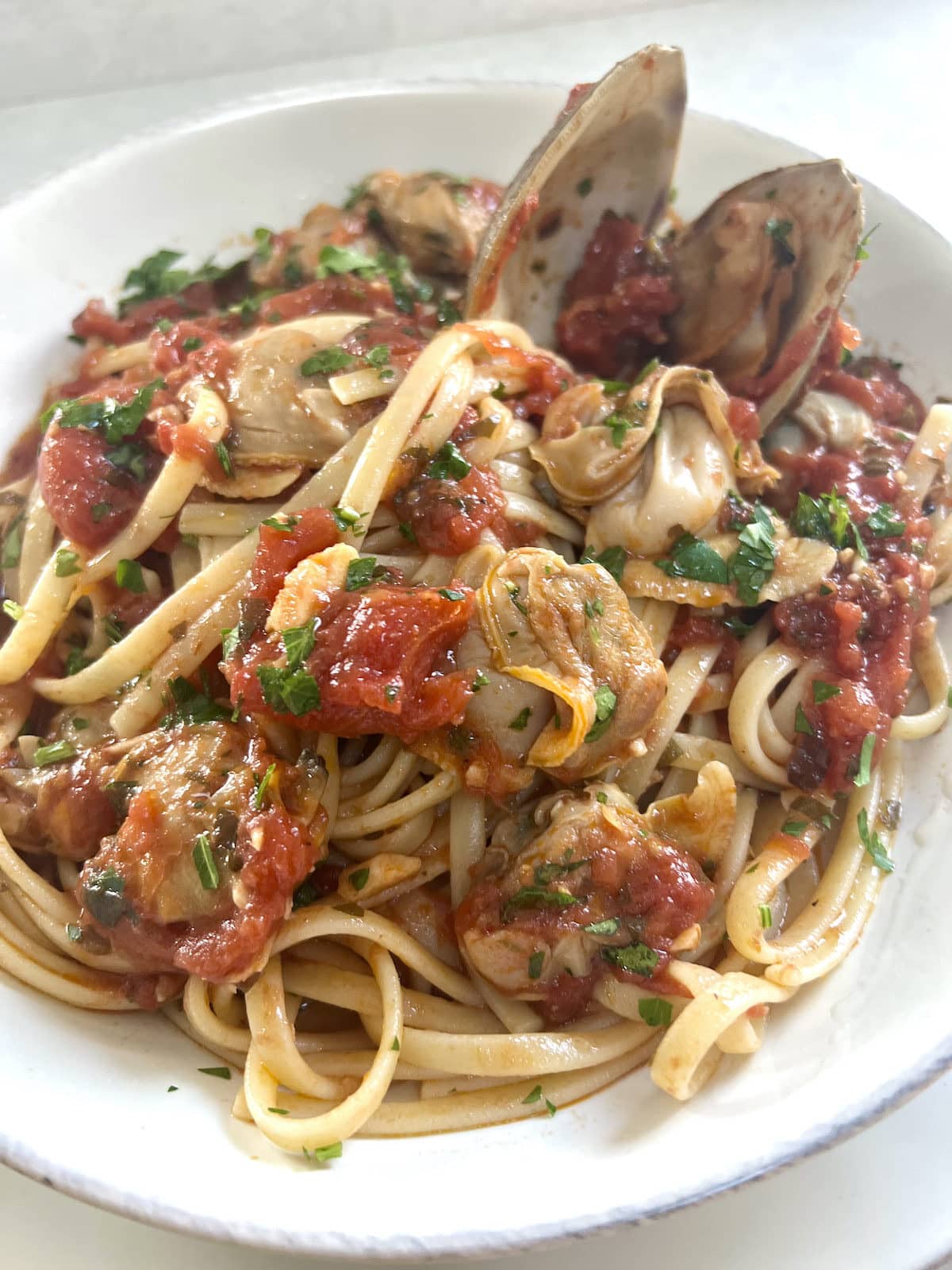
This post may contain affiliate links or sponsored content. That means if you click on my link and buy something, I will earn a small commission from the advertiser at no additional cost to you. For more information on this, please click here.
Linguine with Authentic Italian Red Clam Sauce is a classic pasta recipe with so much flavor from briny clams in savory tomatoes with white wine, lots of pungent garlic and a bit of anchovy and fresh parsley. You will definitely need to plan on seconds for this one!
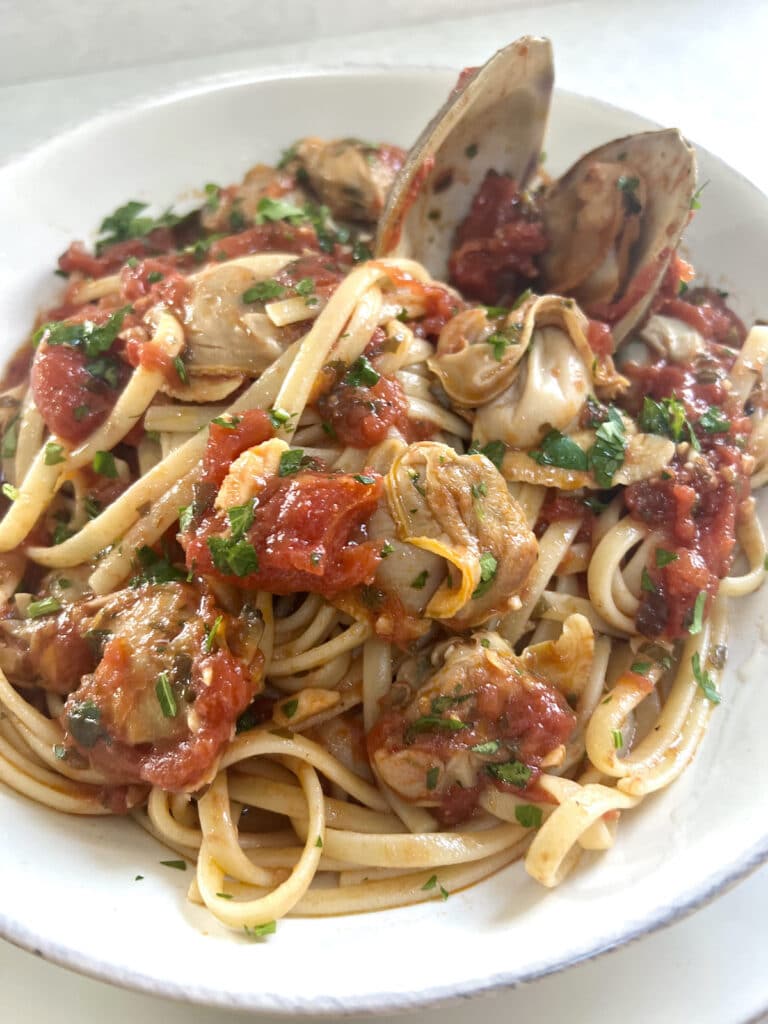
Ever since the first time I had Linguine alle Vongole, it has been one of my all-time favorite pasta dishes and seafood recipes.
But, I don’t think I really understood how wonderful and irresistible this classic could be until I had a beautiful bowl of it in Rome back when I was there on sabbatical years ago.
It was savory and briny and garlicky and just rich enough with silky extra virgin olive oil and a bit of butter. It was simple and clean–as things generally are in bella Italia–and, it was perfect.
This recipe is an homage to that first briny, savory bite. I love to enjoy it during the summer with local clams and also on Christmas Eve’s Feast of the Seven Fishes menu.
If you enjoy clams, also check out Clams Posillipo in Red Sauce and Clams Oreganata with Lemon Garlic Breadcrumbs.
Serve Linguine and Clams With or Without Shells?
Removing the clams from the shells is a personal decision. After years of serving this dish with the clams still in their shells, I now remove all (but a few for aesthetics) clams from the shells and combine them directly with the sauce. It makes the dish so much easier to eat!
Few pasta dishes are as simple and exquisite as this Linguine with Red Clam Sauce. If you enjoy seafood, I hope you give this recipe a try. Mangia bene!
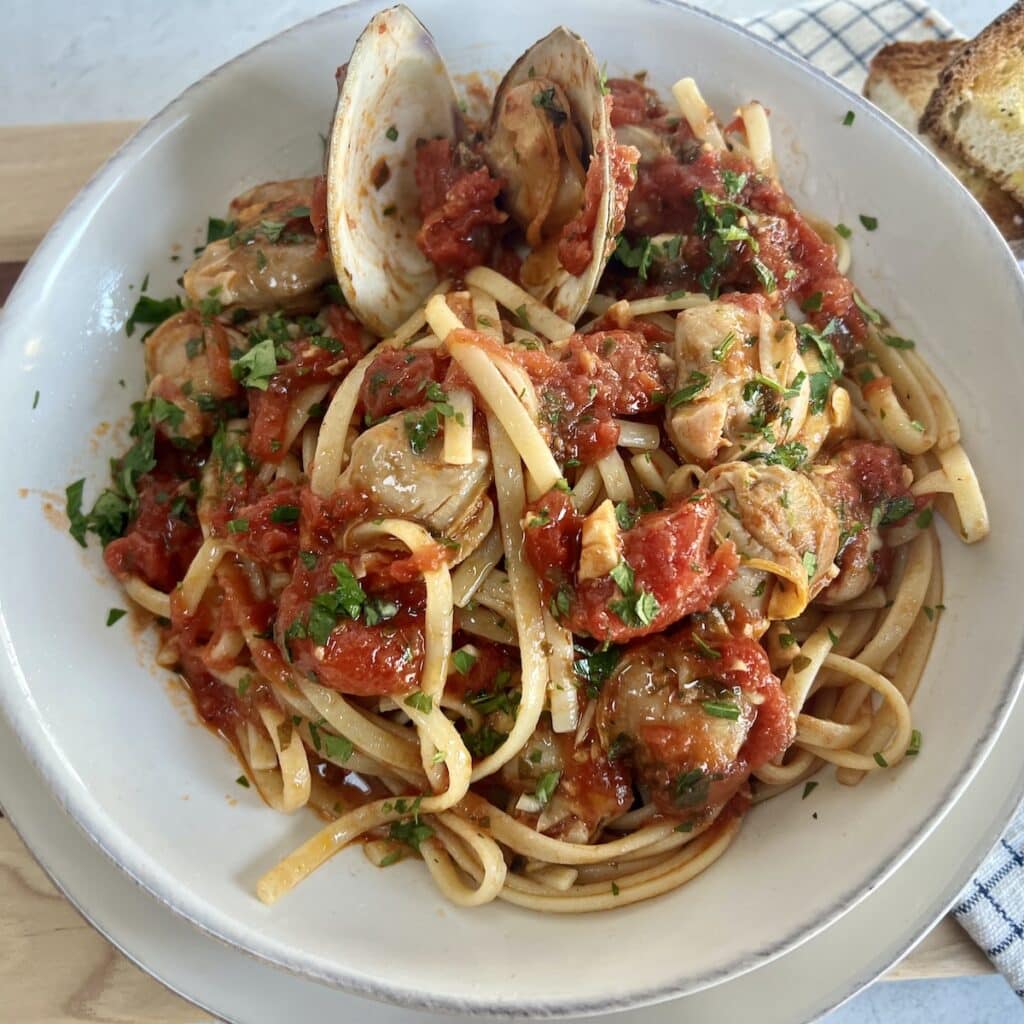
Ingredients for Authentic Italian Red Clam Sauce
Here are the ingredients we’ll need for this Linguine with Authentic Italian Red Clam Sauce Recipe:
- Clams: Either top neck or littleneck clams (both hardshell clams) work well in this recipe. Larger clams, such as chowder or cherrystone, can be used, but their meat should be chopped as they tend to be tougher and chewier. Also, if you are not able to get your hands on fresh clams, you can definitely make this dish with canned clams. (See Substitutions section below.)
- Pasta: Linguine is the classic and preferred pasta for this dish, but it is still really great with almost any long pasta shape, such as spaghetti, bucatini or capellini.
- Tomatoes: I generally prefer to use whole canned tomatoes and then hand crush them as they are less processed than other types. However, you can also use diced or even crushed tomatoes (if you prefer a smoother sauce) in this recipe. Also, choose a high-quality canned tomato, such as a San Marzano tomato, for this recipe. As there are so few ingredients, their quality really matters.
- Anchovies: Anchovies add lots of umami (savoriness) to the recipe. They are meant to enhance the overall flavor of the sauce in a subtle way and to not overpower it. You can omit them, if desired.
- Wine: Choose a light and dry white wine for this recipe, such as a Pinot Grigio or Sauvignon Blanc. The wine adds an extra layer of depth and complexity, brings a layer of acidity to the dish, and rounds out the overall flavor of the sauce. If you prefer to not use alcohol, though, you can leave it out and perhaps add a splash of fresh lemon juice at the end.
- Garlic and Fresh Parsley: Both are important aromatics in the recipe. If you don’t have any fresh parsley, I recommend just omitting it and not substituting dried parsley. Parsley also adds a nice brightness to the dish as a final garnish as it pairs nicely, in general, with seafood.
- Extra Virgin Olive Oil: Used to sauté the aromatics and add some final richness to the finished pasta.
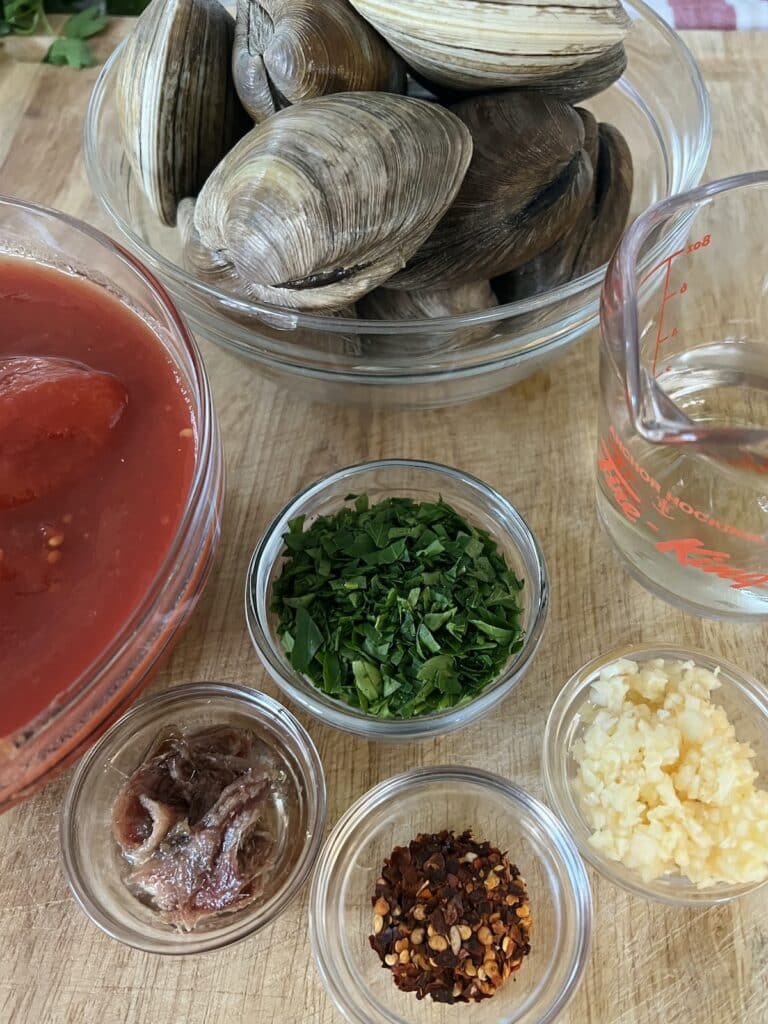
Authentic Italian Red Clam Sauce, Step-by-Step
Here are the main steps for making this linguine and clams with red sauce:
- Purge the clams of excess sand by immersing them in cold, salted water. (See details in recipe below.)
- PRO-TIP: Even if the fishmonger claims that his clams are already purged, I still purge them myself.
- PRO-TIP: Either littleneck or top neck clams work well in this recipe. If using a larger clam, such as cherrystone or chowder clams, be sure to chop them after cooking as they tend to be chewy and tough.
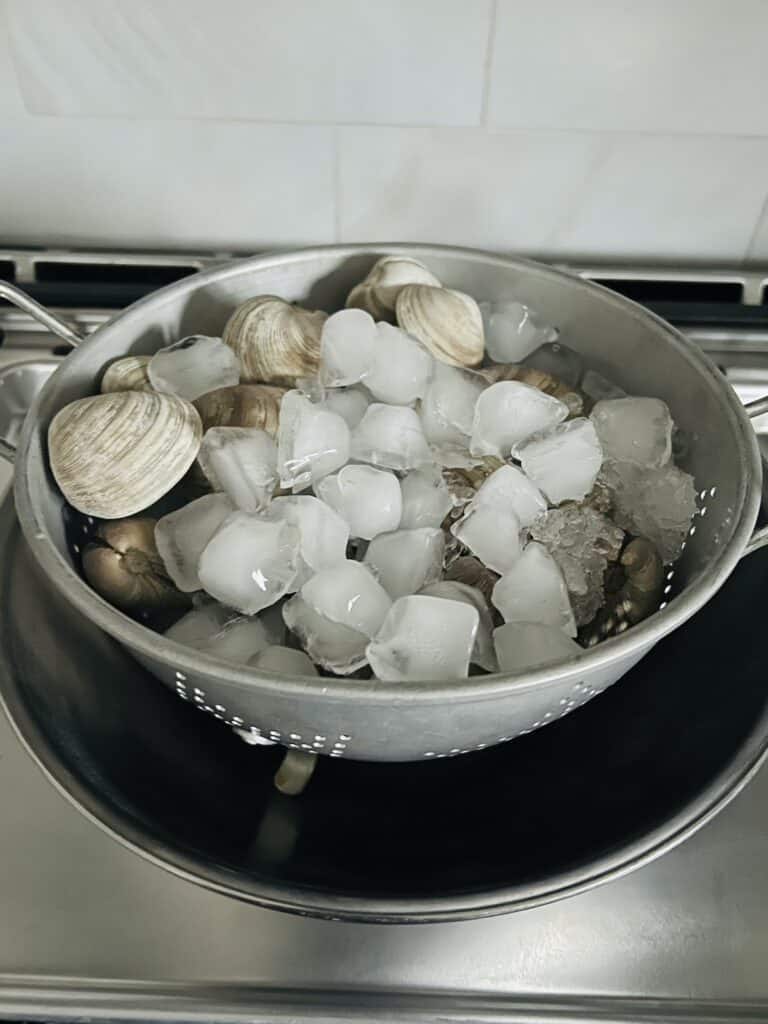

- Put a large pot of water on to boil. Then, combine the olive oil, chopped garlic cloves, anchovies and crushed red pepper in a large saucepan over medium low heat and cook until the garlic starts to soften and brown and the anchovies have dissolved, about 4 to 5 minutes.
- Pour the wine in the pan and scrape up any brown bits.
- PRO-TIP: If you prefer to omit wine in this dish, you can substitute it with vegetable, chicken or seafood broth or clam juice.
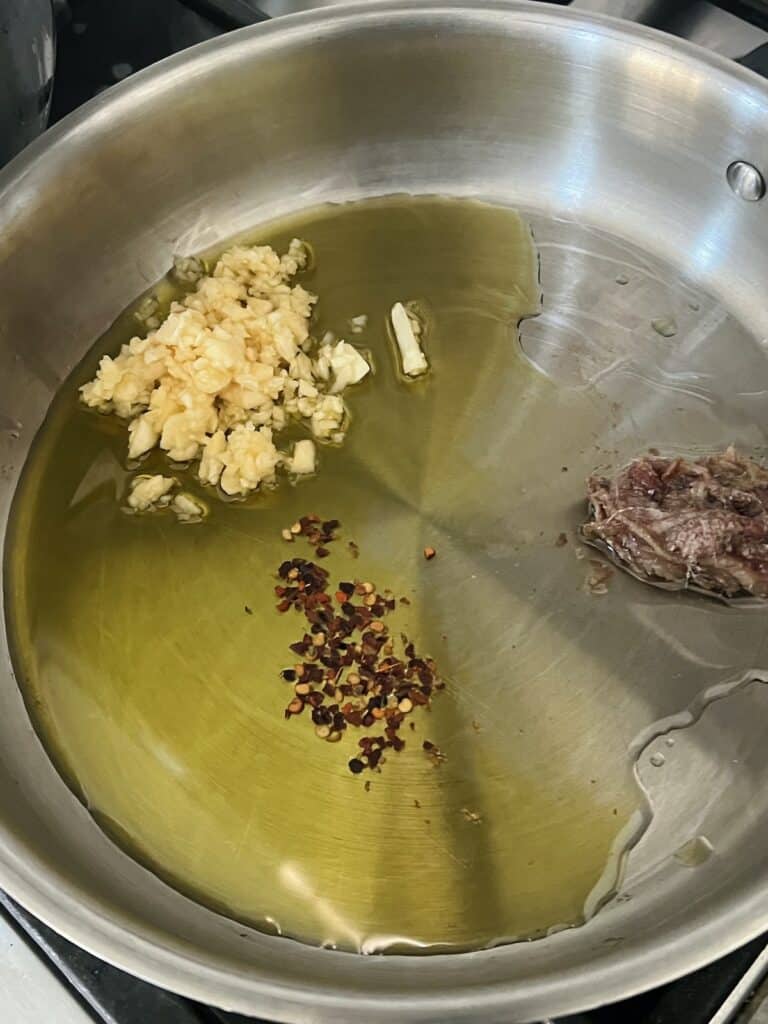
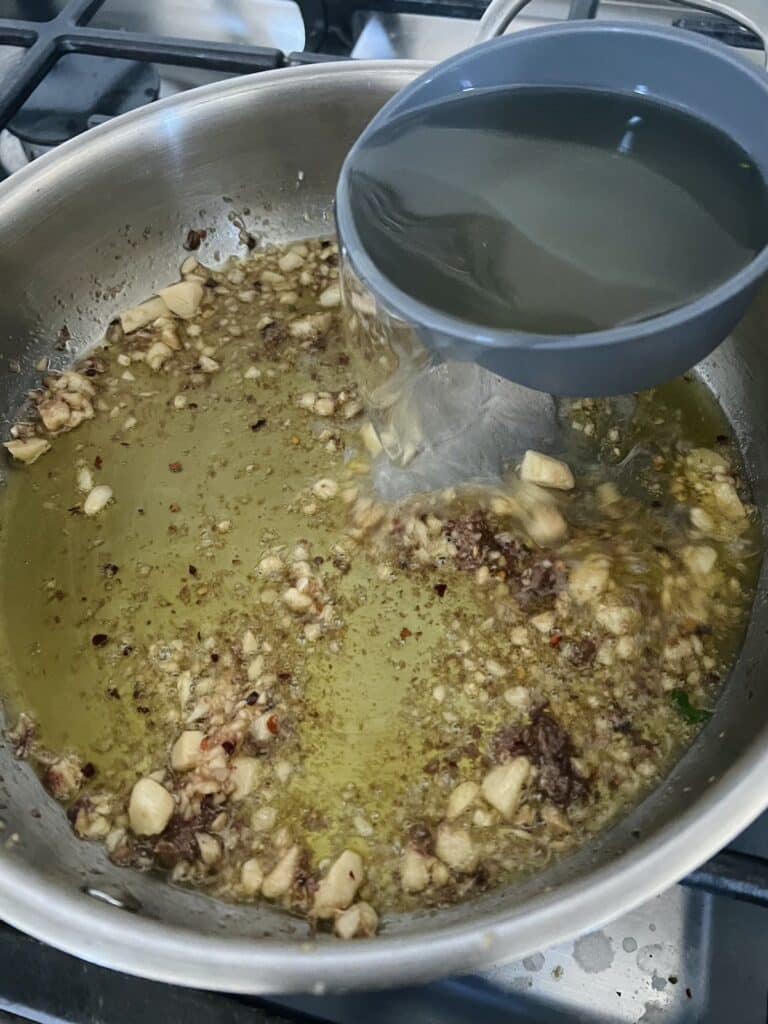
- Then, add the tomatoes, half the chopped parsley, salt and freshly ground black pepper and stir until well-combined.
- PRO-TIP: Note that the clams will add additional saltiness to the dish.
- Bring the tomato mixture to a simmer and simmer, uncovered for about 10 minutes or so to reduce and thicken the sauce and allow the alcohol taste to cook off.
- PRO-TIP: Choose a high-quality canned tomato, such as a San Marzano tomato, for this recipe. As there are so few ingredients, their quality really matters.
- PRO-TIP: You can return the clams to the refrigerator after cleaning without any ice while the tomato sauce is cooking.
- Then, carefully add the cleaned clams to the simmering tomato sauce. Stir gently and distribute them evenly across the surface of the pan. Cover, lower the heat to medium low and let them steam, shaking the pan and gently stirring a few times as they cook.
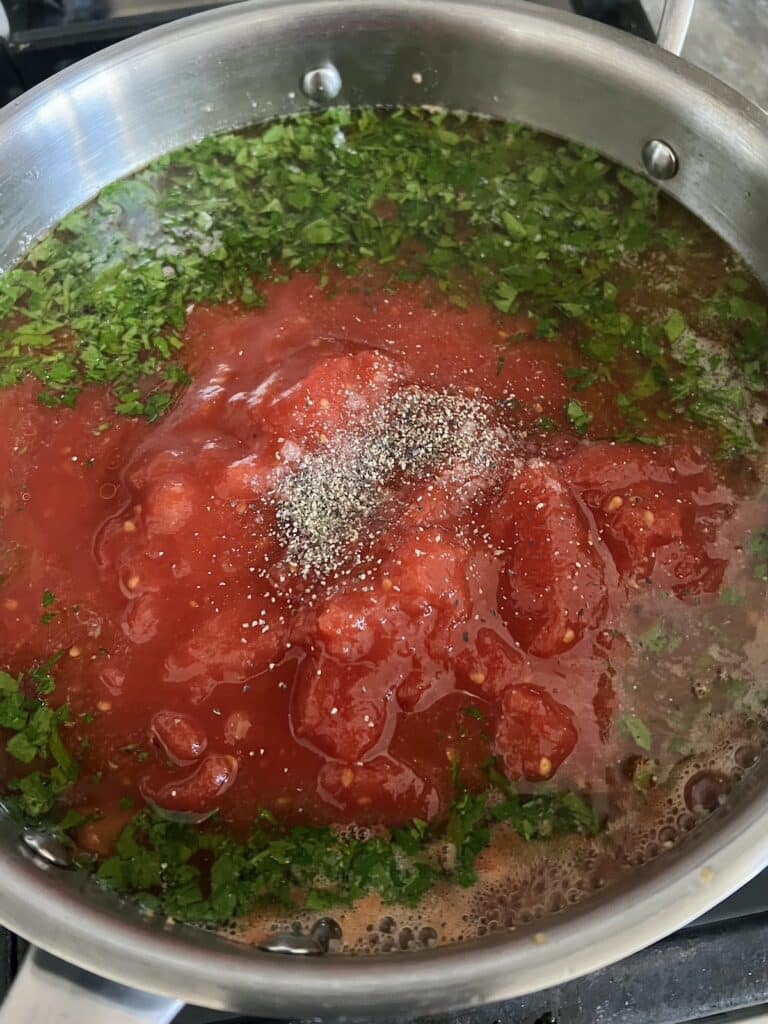
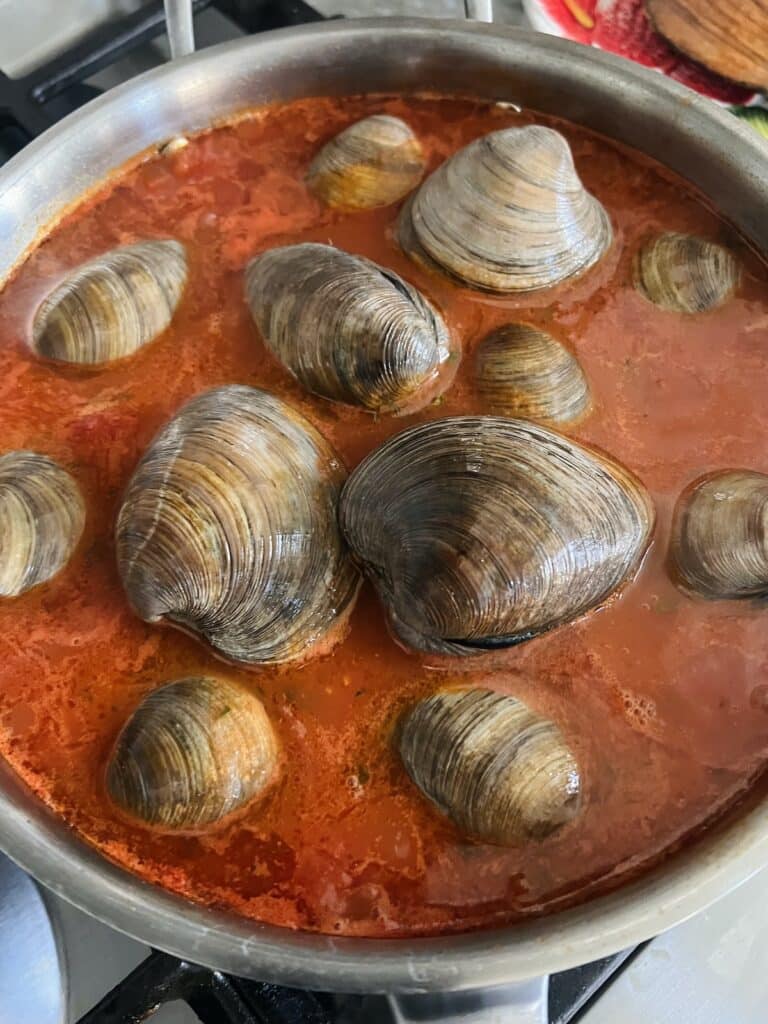
- The clams are cooked once they open! Transfer clams to a bowl one-by-one with tongs or a slotted spoon as they are cooked/opened, and replace the cover as the remaining cook.
- PRO-TIP: Discard any clams that did not open. It may take around 10 minutes or so for all the clams to cook.
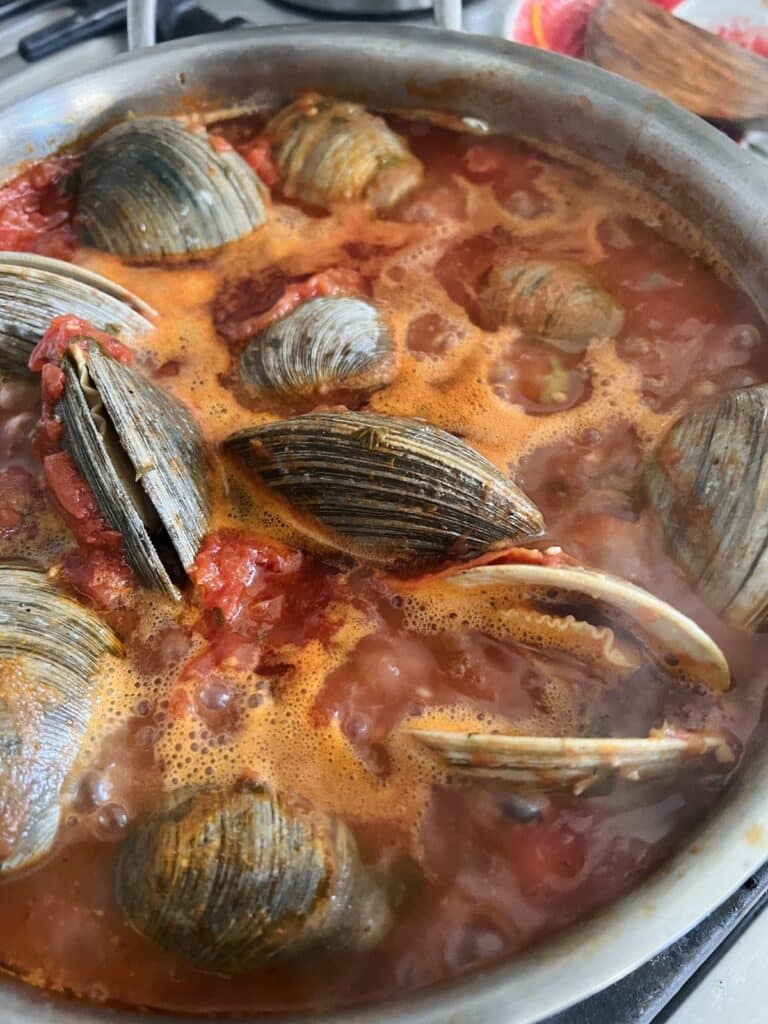

- Once the water comes to a boil, add salt, then the pasta and cook it for 2 minutes less than the package instructions, or two minutes less than al dente.
- While the pasta is cooking, remove the clams from the shells and combine them with the sauce. Hold the sauce on warm while the pasta cooks.
- PRO-TIP: Removing the clams from the shells is a personal decision. After years of serving this dish with the clams still in their shells, I now remove all (but a few for aesthetics) clams from the shells and combine them directly with the sauce. It makes the dish so much easier to eat!
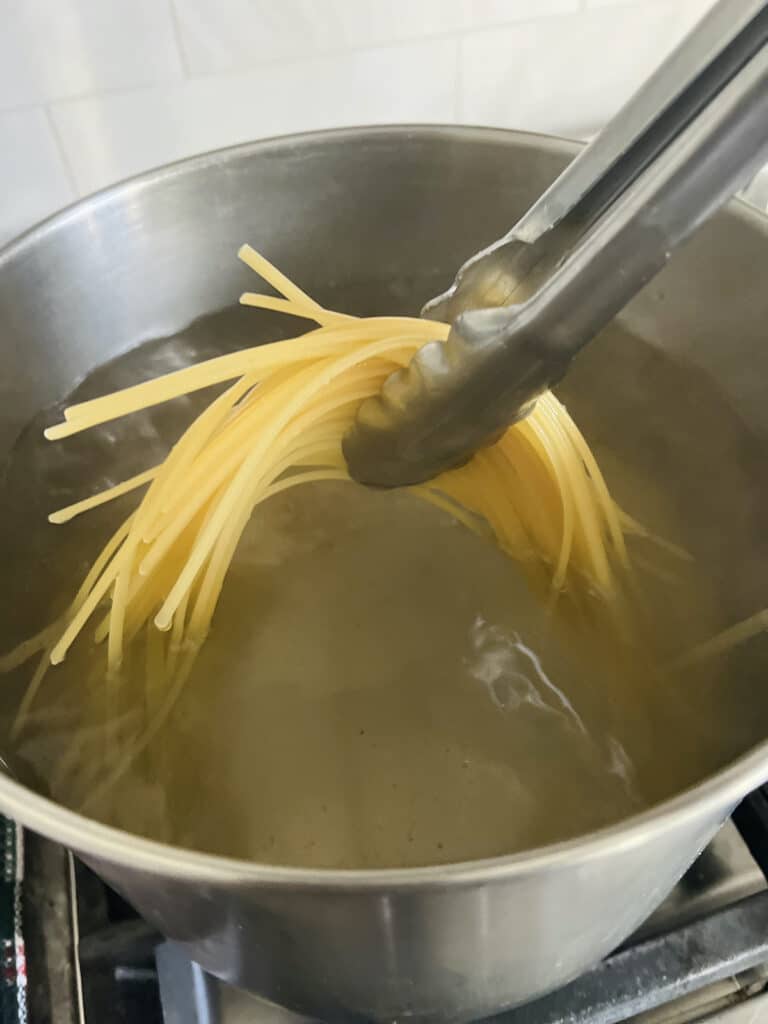

- When the pasta is ready, transfer it to the clam/tomato sauce mixture along with some starchy pasta water and increase the heat.
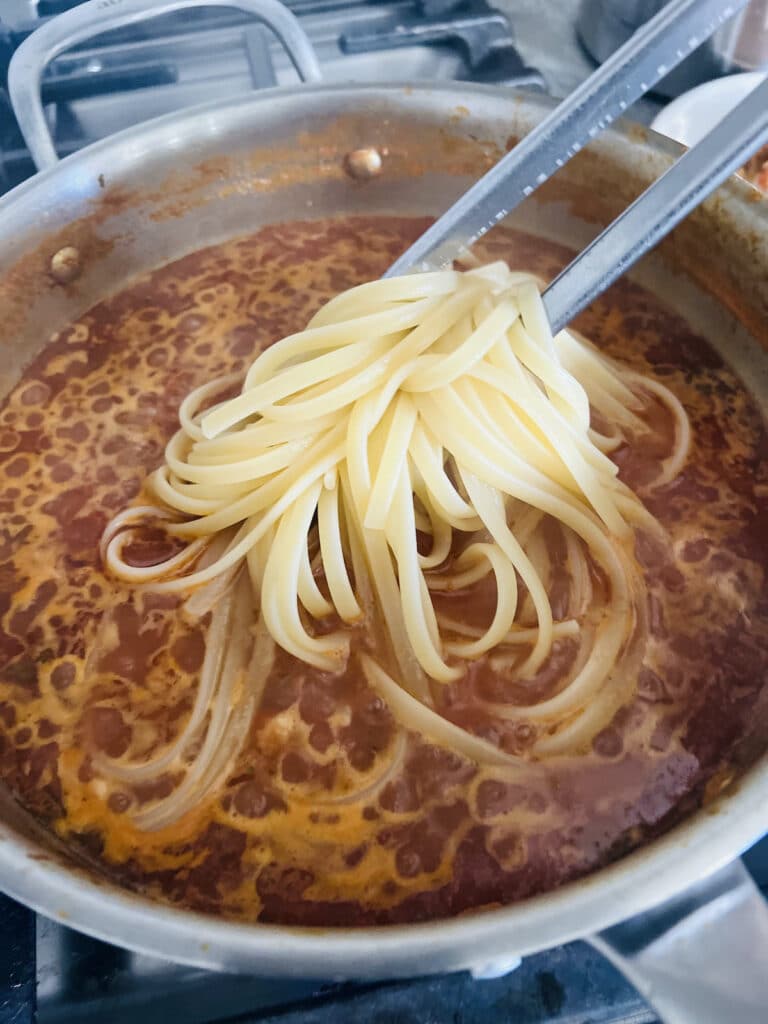

- Stir well to fully combine all ingredients and let the pasta finish cooking in the sauce and absorb all of those wonderful flavors! Add additional pasta water if more moisture is needed.
- Once the linguine is al dente, turn off the heat, fold in the remaining parsley and drizzle a healthy glug of high-quality olive oil over the pasta, stir and serve. That’s it!
- PRO-TIP: If you are leaving the clams in their shells, be sure to include a small bowl for discarded shells.


FAQs for Authentic Italian Red Clam Sauce
The difference is, mainly, that one version (red) contains tomatoes and the other version (white) does not. In addition, linguine in a white clam sauce commonly includes a little butter and more white wine than its red counterpart. Some white clam sauce recipes also call for a bit of lemon juice.
Either littleneck or top neck clams (both hardshell clams) work well in this recipe. Larger clams, such as cherrystone or chowder clams, tend to be chewy and tough and are best chopped before using. But, you can use them in this recipe if you remove them from the shell and chop them before tossing them with the pasta.
When buying fresh clams, make sure the clams do not have cracked or broken shells and ensure the clam shells are tightly closed. Give any open-shelled clams a tap, and if they don’t shut, discard the clam. (Open clams or clams with damaged shells are indicators of dead clams, which you should never eat.) Fresh clams should smell like the sea, not fishy.
Live, fresh clams would ideally be used the same day that they are purchased, but they can last in the refrigerator for about one to two days. Clams must remain alive until cooked.
Store the fresh clams on a bed of ice (with some ice on top as well) in a colander inside of a bowl, uncovered. (See photo above for reference.) Some people say to cover the clams with a damp cloth or paper towel, but I have never done this.
You can also store them in a netted or perforated bag in the back of your refrigerator (the coldest part of the fridge away from the door). Never store them in close plastic as they will suffocate and die.
Purging clams means freeing them of any sand and grit that is held inside of their shells. Clams must be purged before cooking so that you don’t end up with sand in your food!
To purge clams, fill a large bowl with a mix of cold (never hot!) water and, ideally, fine sea salt. In order to match the salinity of seawater, mix about ¼ cup salt into 3 to 4 quarts water. Then, carefully immerse the clams in the salted water and let them soak for about one to two hours to allow the clams to purge sand from their shell. Remove the clams from the water– do not run the clams through a strainer because you will cover the clams in sand. You should see sand in the bottom of the bowl. Repeat this process if you think necessary (i.e., if the water is very cloudy with sand.)
Rinse the clams with cool water and then they are ready to use!
Yes. If you’re not able to get your hands on fresh clams, you can definitely make this dish with canned clams. I suggest using 2 to 3 (10-ounce) cans of baby clams with about half of their clam juice. They can be combined with the tomato sauce in the recipe. Alternatively, you can also use a combination of canned whole or chopped clams and fresh clams to extend the dish.
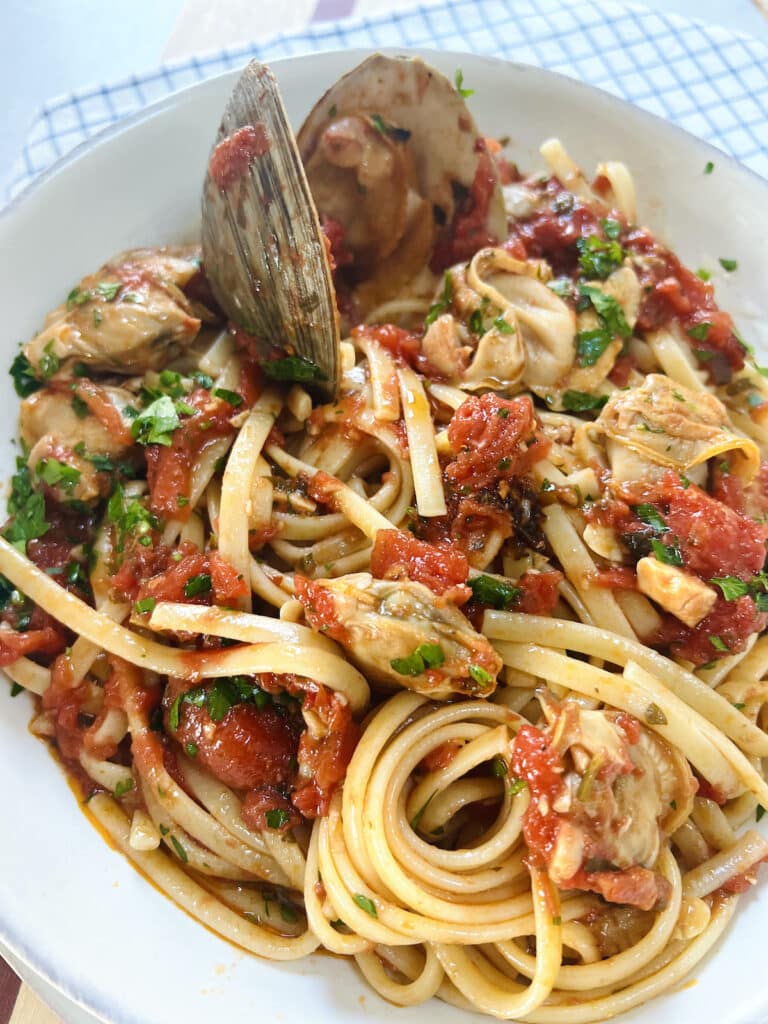
Try serving this recipe with Sautéed Broccoli Rabe or Roasted Zucchini A Scapece–both are delicious pairings! And, don’t forget to serve it with a little homemade Italian chili oil for a final kick of heat!
Recipe Substitutions and Variations
Here are a few delicious ways to change up this red clam sauce recipe:
- Use Canned Clams or a Combination of Fresh and Canned: If you’re not able to get your hands on fresh clams, you can definitely make this dish with canned clams. I suggest using 2 to 3 (10-ounce) cans of baby clams with about half of their clam juice. They can be combined with the tomato sauce in the recipe. Alternatively, you can also use a combination of canned whole or chopped clams and fresh clams to extend the dish.
- Add Butter: For a more restaurant-style finish, add two tablespoons butter to the finished pasta along with the final drizzle of olive oil. This will create a silkier and richer pasta.
- Add capers and/or olives: For a briny, savory and umami punch, add some drained capers and/or chopped black, oil-cured olives to the pan along with the garlic.
- Use Fresh Tomatoes: Substitute two pints fresh grape or cherry tomatoes (quartered) instead of the canned tomatoes for a chunkier and lighter sauce. You may also want to add one tablespoon of tomato paste to thicken the sauce a bit and increase the tomato-ness.
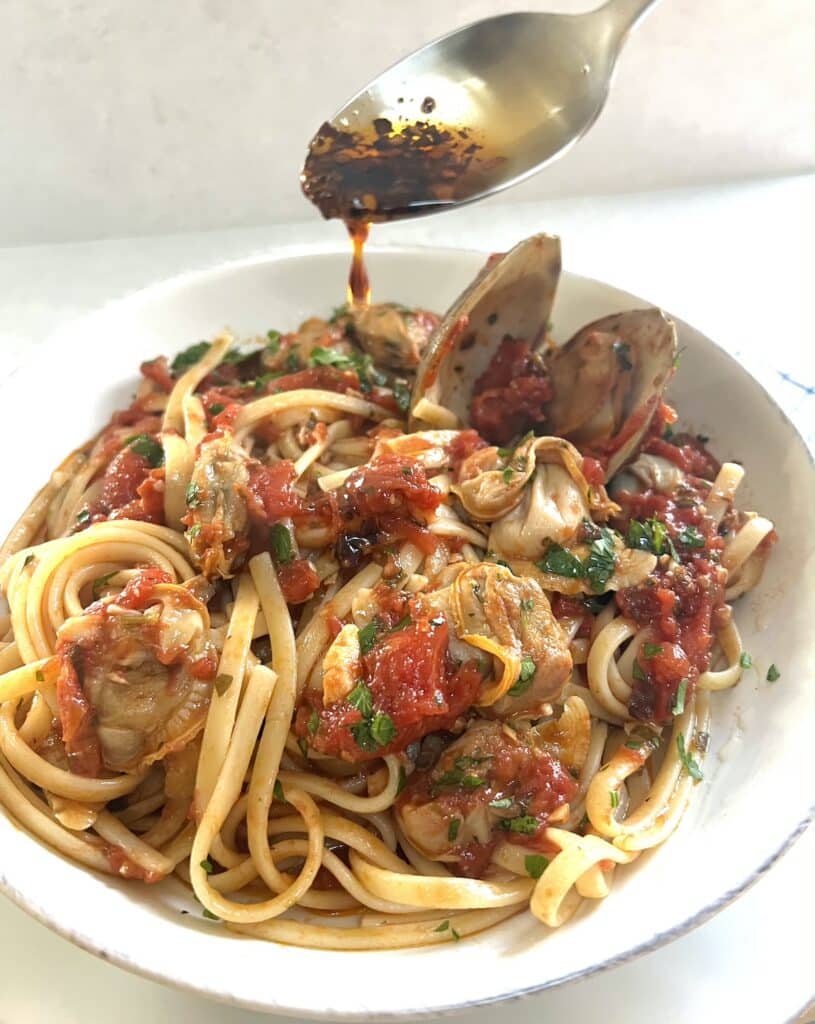
Check out my answer to “How Much Salt Should You Add to Pasta Water?” here, as featured in Appetito’s online Italian Food and Drink Magazine. (Hint: I also mention it in the recipe below.)
More Italian Seafood Pasta Recipes
Seafood and pasta go together like tomato and basil. Here are some of my other favorite combinations:
- Spaghetti and Crabs
- Calamari Ragu Fra Diavolo
- Shrimp Scampi Pasta with Arugula
- Bucatini with Tuna Ragu
- Quick and Easy Spaghetti with Lump Crabmeat
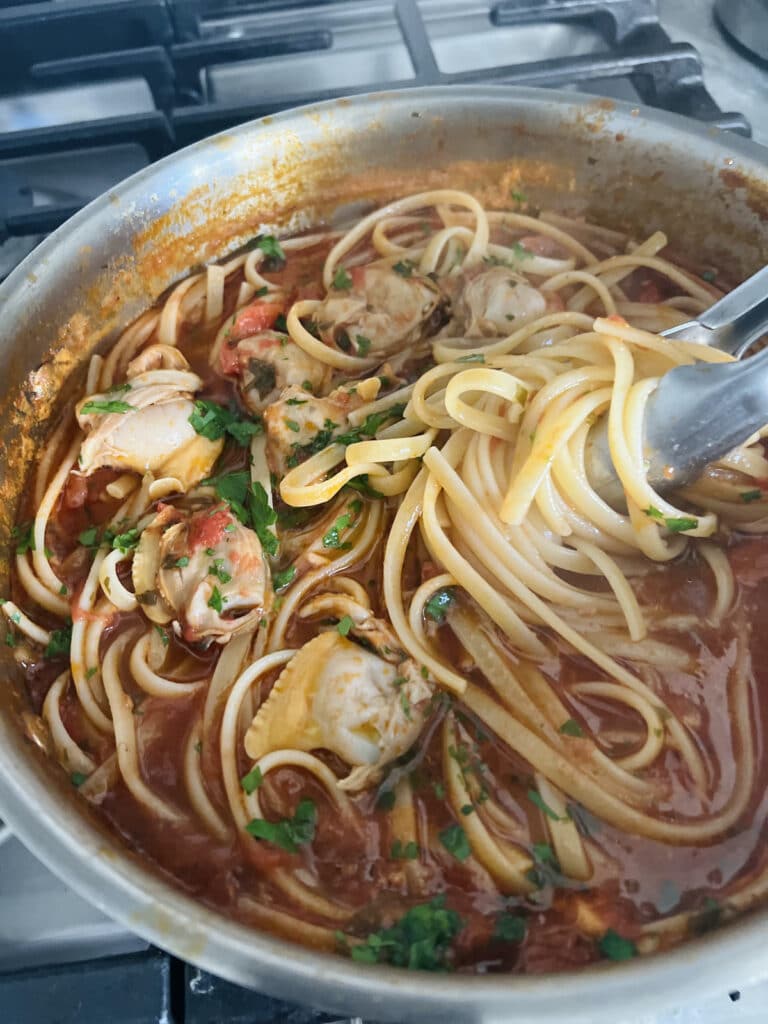
More Italian Recipes to Try
I hope that you are enjoying my Italian food blog Mangia With Michele and all of my Italian recipes!
If you’ve tried Linguine with Authentic Italian Red Clam Sauce or another recipe here, let me know how it went in the comments below. I love hearing from you!
FOLLOW ME on FACEBOOK and INSTAGRAM to see more delicious food and what might be going on behind the scenes!
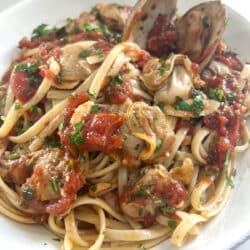
Linguine with Authentic Italian Red Clam Sauce
Ingredients
- 2 dozen clams (top neck or littleneck are best), purged (cleaned–See below.)
- ¼ cup fine salt
- ¼ cup extra virgin olive oil + more for finishing
- 2 Tbsp chopped or thinly-sliced garlic (use more or less, as desired)
- 3-4 anchovy filets or 1 Tbsp anchovy paste
- Pinch crushed red pepper
- 1 cup dry white wine such as Pinot Grigio
- 1 (28-ounce) can whole tomatoes, crushed by hand (See Notes.)
- ⅓ cup chopped flat-leaf parsley leaves divided
- Pinch salt and black pepper
- 1 pound linguine or other long pasta + salt for pasta water
Instructions
- Purge the clams of excess sand: Clean clams with a brush to remove any surface dirt or sand. Fill a large bowl with about 3 to 4 quarts cold water and whisk about ¼ cup salt into it. Then, carefully immerse the clams in the cold water for about 1-2 hours. Either put the bowl in the refrigerator during this resting time or add a few ice cubes to the water so that it is cold. Carefully drain and rinse the clams. If the water is very cloudy, repeat this process as many times as needed until the water is fairly clear. Once the clams have been purged, give them a quick rinse. If it is still going to be awhile before you cook them, return them to the refrigerator stored on a colander in ice.(Please see the section above in the blog post for Step-By-Step instructions with photos.)2 dozen clams, ¼ cup fine salt
- Meanwhile, prep and gather all ingredients according to specifications above. Put a large pot of water on to boil.
- Combine the olive oil, garlic, anchovies and red pepper flakes in a large skillet over medium low heat and cook until the garlic starts to soften and brown and the anchovies have dissolved, about 4 to 5 minutes. (NOTE: You can use anchovy oil here, if desired.)¼ cup extra virgin olive oil, 2 Tbsp chopped or thinly-sliced garlic, 3-4 anchovy filets, Pinch crushed red pepper
- Pour the wine in the pan and scrape up any brown bits. Then, add the tomatoes, half the chopped parsley, salt and black pepper and stir until well-combined. (Note that the clams will add additional saltiness to the dish.)1 cup dry white wine, 1 (28-ounce) can whole tomatoes,, ⅓ cup chopped flat-leaf parsley leaves, Pinch salt and black pepper
- Bring the tomato mixture to a simmer and simmer, uncovered for about 10 minutes or so to reduce and thicken the sauce and allow the alcohol taste to cook off.
- Then, carefully add the cleaned clams to the simmering tomato sauce. Stir gently and distribute them evenly across the surface of the pan. Cover, lower the heat to medium low and let them steam, shaking the pan and gently stirring a few times as they cook.2 dozen clams
- The clams are cooked once they open! Transfer clams to a bowl one-by-one as they are cooked/opened, and replace the cover as the remaining cook. Discard any clams that did not open. It may take around 10 minutes or so for all the clams to cook.
- Once the water comes to a boil, add salt, then the pasta and cook it for 2 minutes less than the package instructions, or two minutes less than al dente.1 pound linguine or other long pasta
- While the pasta is cooking, remove the clams from the shells and combine them with the sauce. (See NOTE below regarding serving the clams in their shells, which is an option.) Hold the sauce on warm while the pasta cooks.
- When the pasta is ready, transfer it to the clam/tomato sauce mixture along with about ½ cup of the starchy pasta water (to start) and increase the heat to medium. Stir well to fully combine all ingredients and let the pasta finish cooking in the sauce and absorb all of those wonderful flavors! Add additional pasta water if more moisture is needed.
- Once the linguine is al dente, turn off the heat, fold in the remaining parsley and drizzle a healthy glug of high-quality olive oil over the pasta, stir and serve. Buon Appetito!
Notes
- Even if the fishmonger claims that his clams are already purged, I still purge them myself.
- Either littleneck or top neck clams work well in this recipe. Larger clams, such as cherrystone or chowder clams, tend to be chewy and tough and are best chopped before using. But, you can use them in this recipe if you remove them from the shell and chop them before tossing them with the pasta.
- If you prefer to omit wine in this dish, you can substitute it with vegetable, chicken or seafood broth or clam juice.
- It’s best to use clams or any live shellfish on the same day that you purchase them. However, if you are not cooking them immediately once purchased, the best way to store them (for one day only) is on a bed of ice (with some ice on top as well) in a colander inside a stainless steel bowl, uncovered. (See photo above for reference.) When ready to use, take them out of the refrigerator and clean/purge them. You can return them to the refrigerator after cleaning without any ice while the tomato sauce is cooking.
- I generally prefer to use whole canned tomatoes and then hand crush them as they are less processed than other types, plus I prefer a chunky sauce. However, you can also use diced tomatoes or even crushed (if you prefer a smoother sauce) in this recipe.
- Also, choose a high-quality canned tomato, such as a San Marzano tomato, for this recipe. As there are so few ingredients, their quality really matters.
- Removing the clams from the shells is a personal decision. After years of serving this dish with the clams still in their shells, I now remove all (but a few for aesthetics) clams from the shells and combine them directly with the sauce. It makes the dish so much easier to eat!
- Use a large pot with 5 to 6 quarts water for 1 pound of pasta. Bring the water to a boil before adding the salt. Use 1 1/2 – 2 Tbsp salt.
- The pasta water is key! Add it to the sauce along with the pasta for the additional moisture needed to finish cooking the pasta.
- Leftovers can be stored in an airtight container in the refrigerator for up to 5 days. Reheat them, covered, in a small skillet over medium low heat with a little bit of water until heated through.

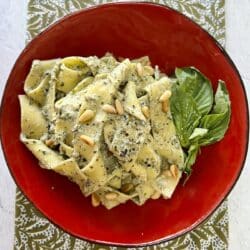
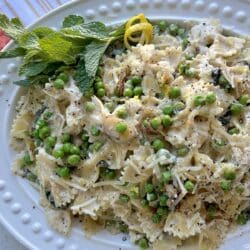
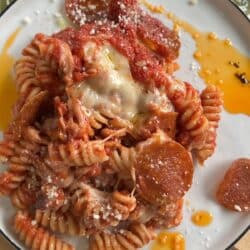
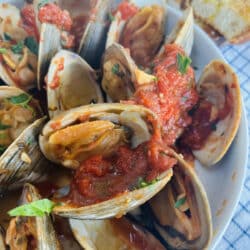
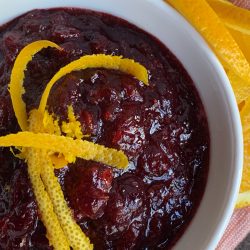
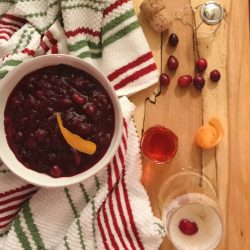

Would you ever add mascarpone, for a cream sauce?
In general, you can certainly use mascarpone for a cream sauce for pasta, but I would not recommend that for this recipe. I don’t think a creamy, dairy-based sauce would work well with this red clam sauce recipe.
I love anchovies but it was the only ingredient I was missing. I substituted 2 TBSP Worcestershire sauce. Delicious
Glad your substitution worked out, Michael! Thanks for the comment. 🙂
Love your instructions! This recipe was so delicious and I especially love the chunkiness of the sauce, which is different than many other recipes I’ve seen. Will make this over and over and over….